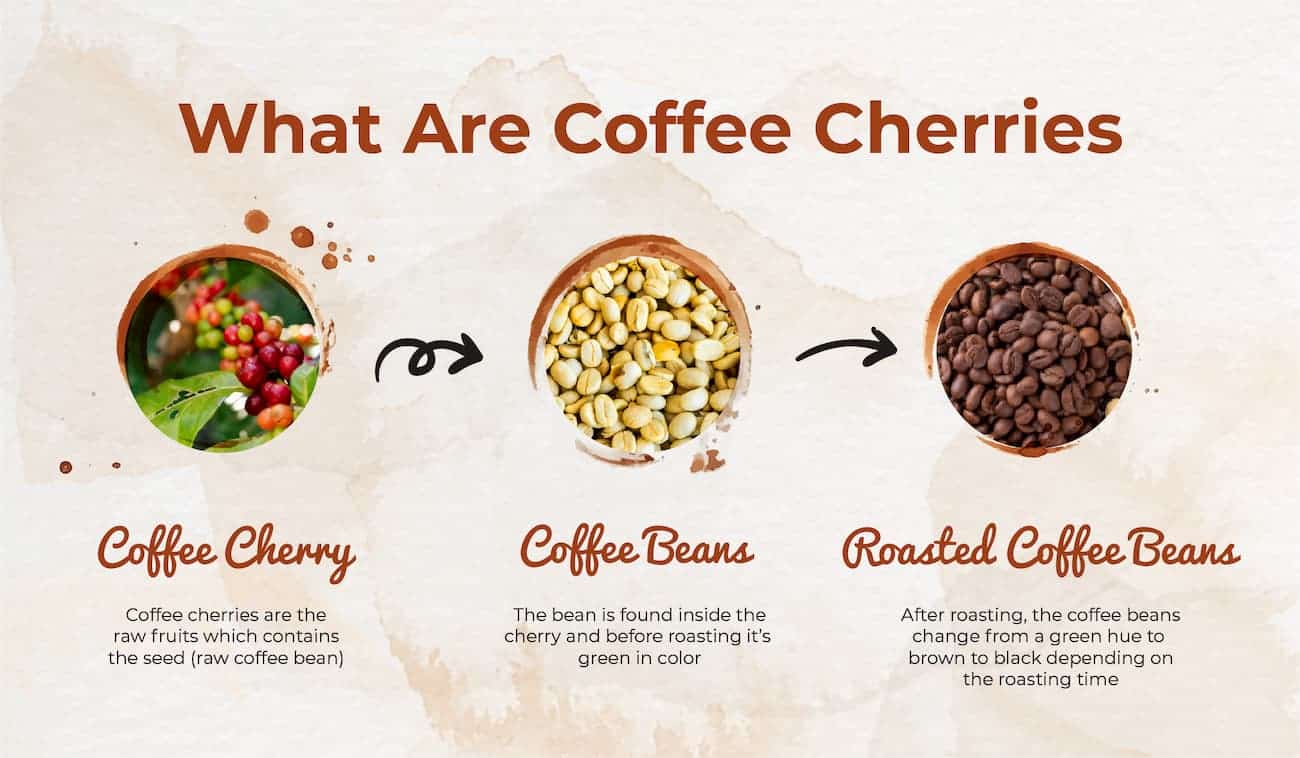What Is The Coffee Cherry & Can You Eat It?
When brewing your favorite bag of beans, you probably don’t often consider that they are just seeds. Yup, seeds. Originating from a coffee cherry.
While most coffee lovers are familiar with the coffee bean, understanding how the former is related to the coffee cherry is less well established between most casual coffee drinkers.
If you want to know more about this particular fruit, scroll down below while you sip on your favorite brew and get acquainted with the coffee cherry.
What’s a Coffee Cherry?
The coffee cherry originates from the fruit-bearing coffee plant. They have a berry-like appearance and start as green, small, and unripe fruit.
Once it matures, the cherry typically turns red, with some turning yellow depending on the variety.

A typical coffee fruit ripens within two months, but sometimes it can take longer if grown at a higher altitude with adequate rainfall. The cherries don’t ripen all at once, and a regular coffee farm can take up to one year to complete a single entire harvest.
When you peel back the cherry, inside is coffee, unroasted but coffee nonetheless.
Once these coffee cherries mature, they’re picked and processed, which can take up to 3 months before they’re roast perfectly and shipped.
Related read: Where coffee beans come from
Are Coffee Cherries edible?
Yes, the short answer is that coffee cherries are edible, but you might find yourself having a hard time trying to chow down.
Unlike most fruits with a wide inner layer, the inside of a coffee cherry only has a thin covering of sugar called the mucilage and a slimy film that protects the bean.
Its skin can be quite rough and sticky while the cherry’s pulp sticks to the bean, similar to a mango or peach. That is not to say that the coffee cherry isn’t tasty; it is quite pleasant, to be fair. A ripe cherry is very sweet and tastes like a watermelon combined with raspberry or apricot.
While it can taste great, there is not enough flesh to justify eating it like other fruits.
Ripe coffee cherries also have little variety, and they usually taste sweet and fruity, but some can even have a floral flavor like jasmine or hibiscus.
The beans, however, can taste vastly different from one another depending on origin and roasting styles.
Does the Cherry matter?
Coffee cherries can taste similar; what’s important is the harvesting of the cherry which ensures the flavor of our brew is as sweet as possible.
The coffee cherry must be picked at its ripest, when they have a dark-red exterior hue. This provides enough time for sugars in the fruit to ferment, leading to a complex and sweet cup of coffee when the seeds are roasted.
Picking a ripe cherry can only do so much. What matters more is how the beans are processed before roasting. Most coffee farmers don’t have the luxury of picking and choosing the method they use. Instead, it’s usually a single processing method given the geographical growing conditions and climate at the coffee farm.
The natural or dry process is the oldest coffee process in the world and is popular in regions where there’s low humidity and rainfall. These coffee farms place the cherries on a flatbed where they end up drying for up to six weeks. Dry-processed coffees are great if you want something with a sweeter taste, and a heavy body. Often with notes of berries, fruits, and even wine depending on the roast.
If you prefer to taste a vibrant and clean cup of coffee, choose a washed or wet-processed coffee is often better for flavor. Unlike the natural method where the cherry is still intact, a washed coffee has the skin and pulp removed until the mucilage remains. The beans are then fermented using water to let the mucilage break down and then dried as usual.
The honey process isn’t new but rather a hybrid of the wet and dry process. Here, the pulp is again removed from the coffee cherry, but there’s no water involved.
The beans are directly dried right after de-pulping as this lessens the risk of over-fermentation inside the coffee, where the sugars are broken down into acids. The flavor of honey-processed coffees vary, but you can expect a good balance of acidity and sweetness in your brew.
Caffeine Content
Coffee has the highest natural source of caffeine, and we mainly consume it from the beans. This is because the coffee seed generates the most caffeine out of all the other parts of the coffee plant, including its leaves. Although, the cherry also produces caffeine but in smaller amounts.
Raw coffee is known to contain a much higher caffeine concentration than roasted coffee, but it comes with two significant drawbacks.
The raw coffee beans need to be roasted before consumption because they are too tough and dense to grind. The roasting process dehydrates and cooks the solid coffee beans until they become brittle.
Roasting the coffee beans and different roast levels give your brew its unique taste that you find so appealing. If you try chowing down on green coffee, you’ll notice it often has a vegetal and earthy taste no matter what origin or species.
Luckily for us, professional roasters know how to make the perfect roast profile for a coffee-based on its processing and growing conditions.
While roasting reduces the caffeine content per bean (due to a reduced total volume), the darker it goes, but it enhances flavor and texture.
Cascara Pulp
Never heard of Cascara? You’re not alone. Most of us haven’t either!
The aptly named Cascara is the Spanish for skin, and it is the free by-product of coffee cherries made from the dried skins and pulp of the fruits.
It’s brewed as a coffee cherry tea, popular as a tea-like drink to share, found commonly across Latin American coffee farms. Although, Starbucks has also adopted Cascara in lattes too. Cascara tastes more tea-like than a coffee drink because of its sweetness, body, and brewing method. It’s known to contain roughly the same amount of caffeine as a cup of black tea.
While it’s different in taste, the cherry skin actually contains the same antioxidants and other health benefits found in coffee. Nonetheless, while it’s a free by-product and available in most of the world, Cascara product sales are currently banned in the European Union until further research has verified that it is safe to consume.
Flavor-wise, in my experience, I’ve found that the dried pulp itself tasted like dates and raisins while the cascara tea added just a hint of jasmine and cinnamon with the sweet fruity flavors.
While eating ripe coffee cherries seems out of the question for most coffee lovers, you might find that a cup made from Cascara is a new experience, and you may even like drinking the caffeinated cherry more than a cup of Joe.
Frequently Asked Questions
Can you chew on coffee beans?
Along with the coffee cherry, the beans are also edible. You might want to go for a roasted bean as raw coffee is quite tough, and it might take some getting used to.
The coffee texture and taste will be vastly different, although chewing on coffee might increase caffeine absorption compared to sipping a cup of Joe.
So for most, it’s better to chew on your favorite roast compared to raw coffee.
Is coffee a fruit?
It might be a misnomer because of the prevalent use of “bean” as a nickname for the coffee seeds, but it’s actually a part of a fruit. The coffee plant grows cherries where the seeds are harvested, processed, and roasted to the drink we know and love.

